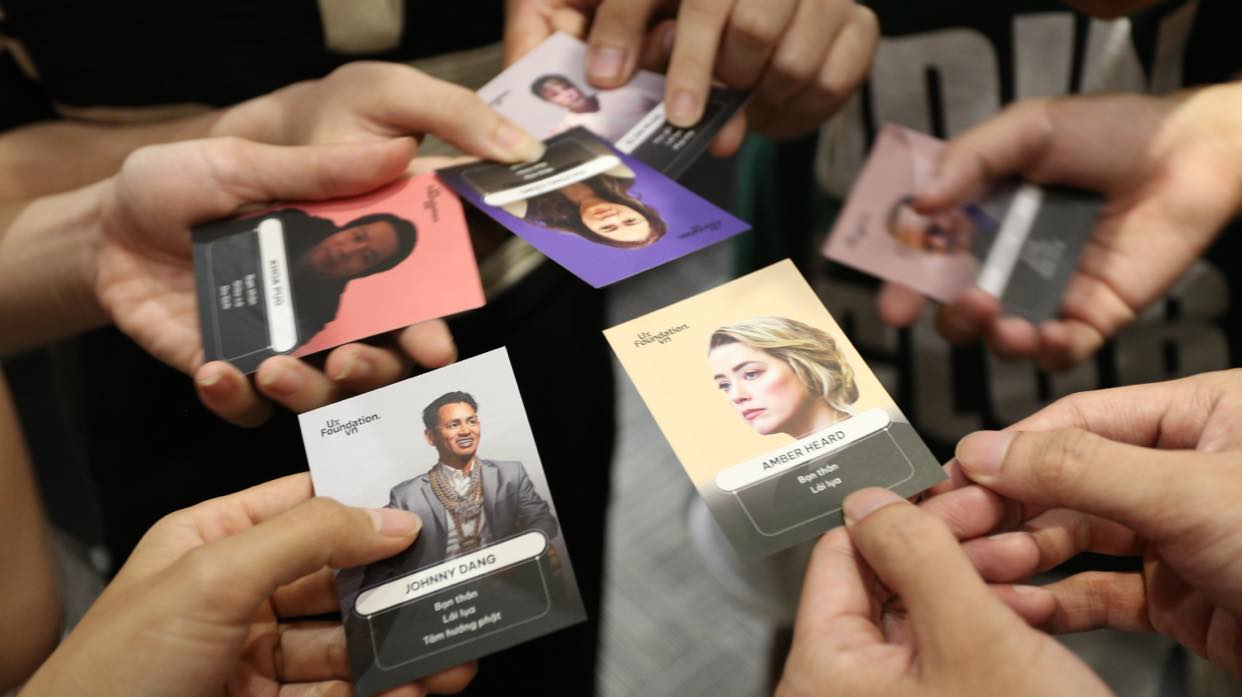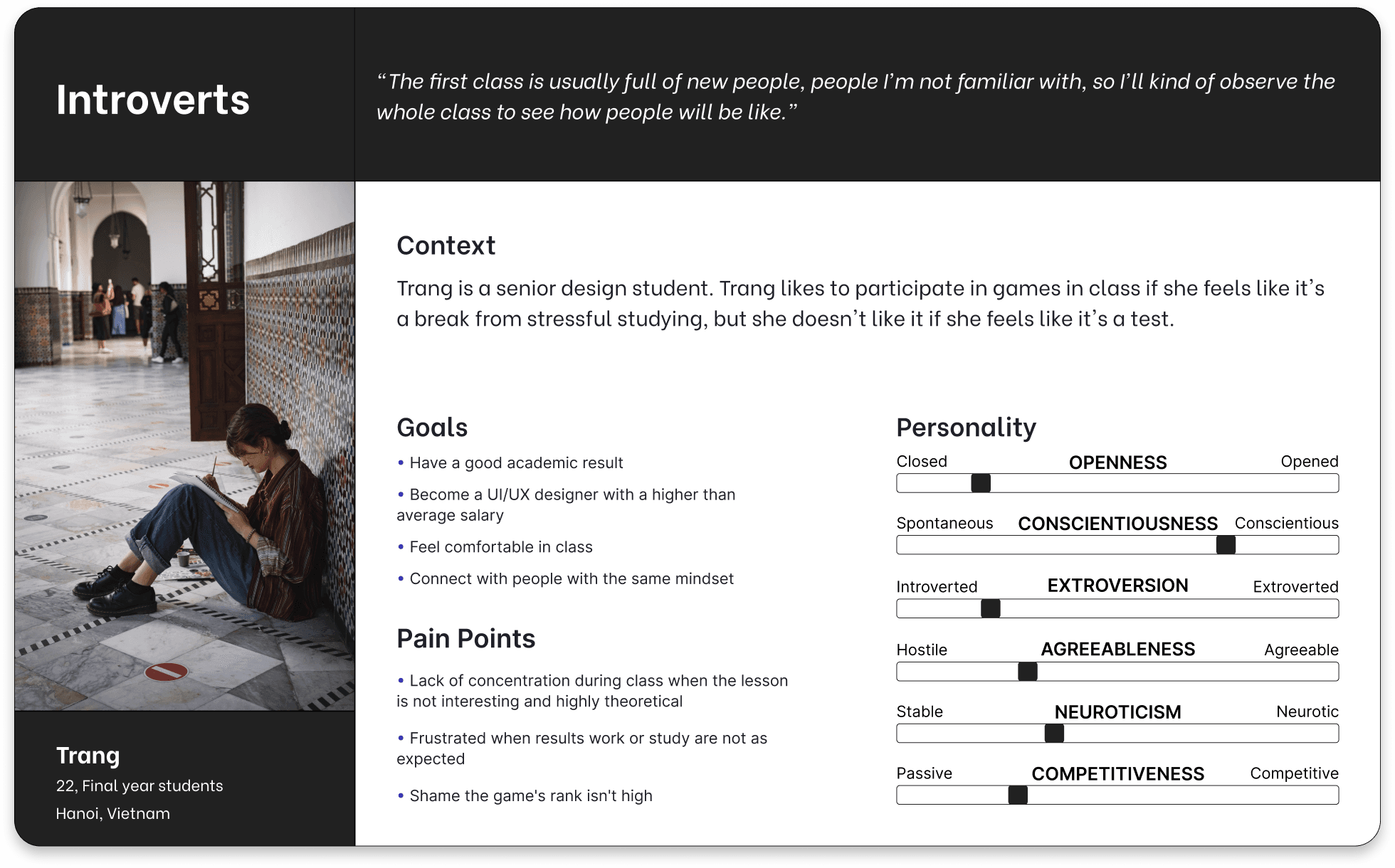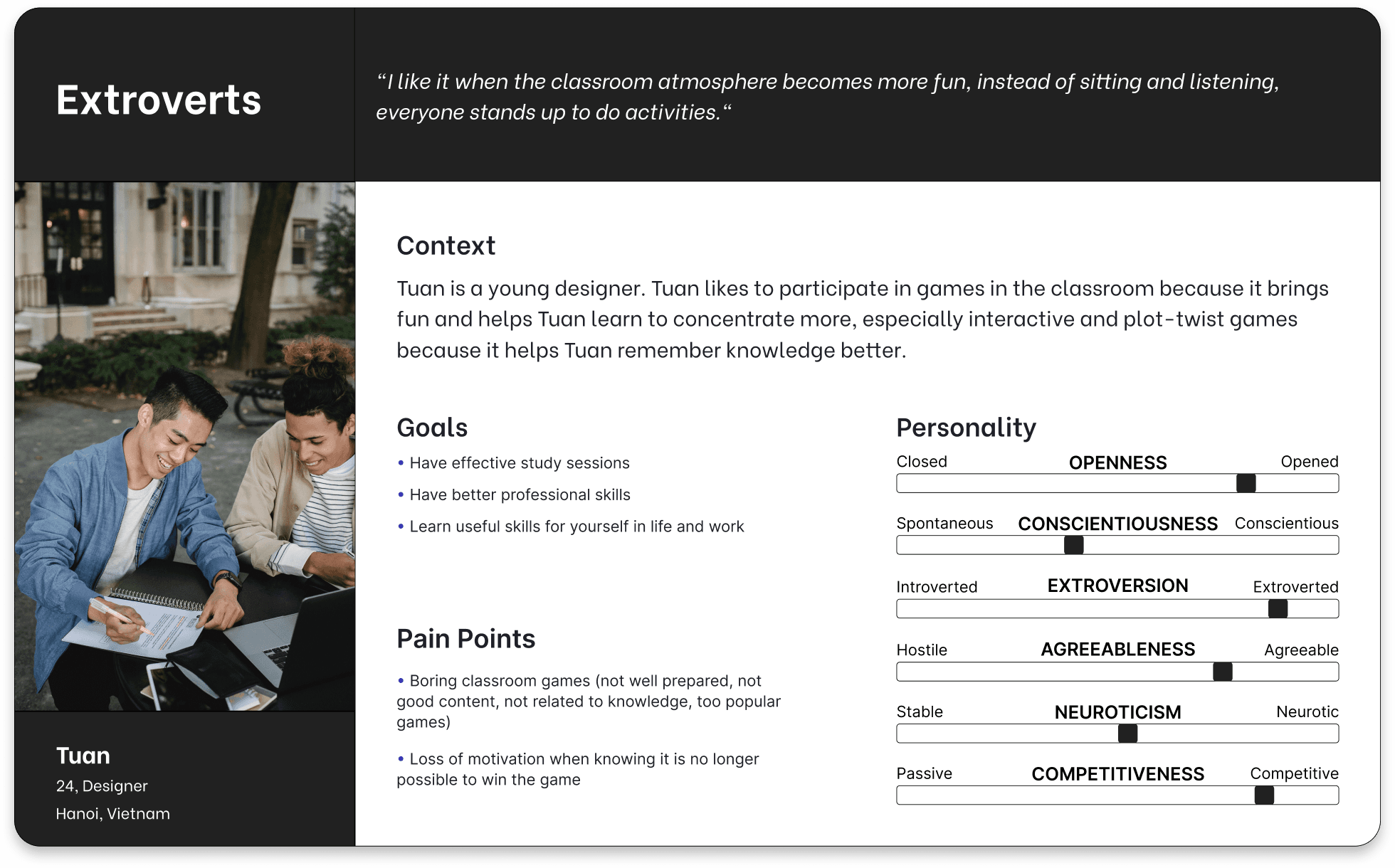Education
Case Study: Helping introverted students easily integrate into the school environment
Case Study: Helping introverted students easily integrate into the school environment
Sep 30, 2022
Sep 30, 2022
My role
Team Leader: Dam Khanh Hoang
UX Designer: Dam Khanh Hoang, Hiep Tran
UX Researcher: Dam Khanh Hoang, Hiep Tran
Overview
This is a project at the UX Foundation, helping to improve classroom quality for students here.



About UX Foundation
UX Foundation is an educational organization focused on UX design training, helping students identify and build solutions to user problems.
The UXF key will make it easier for you to clarify what features need to be done and why. The UXD course will answer the question of how to do it.
Topic
❓ Design an offline in-class game for the UXF course.
Specifically:
Time: No more than 15 minutes, avoid affecting study time
Difficulty level: Medium
Number of players: 10-15 people
Challenge
😖 Foundation but not Foundation
The knowledge in the UXF class is quite heavy and extensive. Not to mention, UX knowledge in general is not easy to quickly understand and apply. This leads to it is not difficult for students to become discouraged and no longer maintain enthusiasm throughout the course, even in each class session.
😪 Class schedule is in the evening
UXF class is held from 7:00 p.m. to 10:00 p.m., one session on weekday and one session on the weekend - the end of the day, when students don't have much energy left. Without activities lifting students' mood and energy, students will have difficulty concentrating in class.
Desk Research
My teammates and I researched the topic **Game-Based learning** on academic resources (RMIT Library) and analyzed and synthesized important information for the problem to be solved.
Objectives of the study
Understand what a good game is
Understand the effects of a good game
Understand how to make a good game
Understand how players interact with the game
Set of questions
💁♂️ Who is the target group that the game is targeting?
❓ Why do they need a good game?
👌🏻 What is a good game?
👟 What are the steps to design a good game?
Key insights
🗯️ Insight #1: Learning should go hand in hand with play because it helps maximize the ability to absorb knowledge
Learners have the opportunity to systematize the knowledge or skills they have just learned, avoiding overload.
Learners will be able to concentrate more intensely after taking breaks in the middle of class, especially in children. According to evidence, the average adult brain can only be in a state of absolute concentration on one subject for no more than 48 minutes, which is why school classes usually only last 45 minutes.
Positive emotion is a very important factor that affects learners' concentration, memory, ability to practice, make decisions, critical thinking, etc.
According to research, up to 89% of students responded that they absorb knowledge more effectively while participating in games and 66% responded that they feel personal growth in games. education. In addition, the rate of distraction during learning was reduced by 30% after learners participated in-class games.
⇒ This helps our team understand the importance of the game, thereby putting more effort into the design.
🗯️ Insight #2: The probability factor helps increase player excitement
A good game requires an element of probability. It reflects real life, where no one has control over all possibilities. According to research, the human brain produces a sudden surge of dopamine when achieving a result with a low probability of success.
⇒ This helps our team have one more job-to-be-done in designing the game.
🗯️ Insight #3: Gen Y feels not too comfortable asking for help
Gen Y sees asking for help as a sign of weakness. In addition, they are influenced by social prejudices, leading to reluctance or little need to express themselves.
⇒ This reminds our team to design a game with rules that are not too difficult to understand, because in the UXF class there are also Gen Y students.
Interview
Due to the short duration of the project, along with the limited number of students who have experienced the class, our team decided to interview potential students of UXF, with the criteria of participation short-term classes and participated in games in the curriculum. This helps our team collect a lot of information from other users, instead of just limiting it to students who have once participated in UXF.
Interview goals
Understand better who participates in-class games
Understand how users participates in the game
Understand how users evaluates the game
Understand the benefits that users receive when participating in the game
Key insights
🗯️ Insight #1: Players feel uncomfortable playing a game if they feel it is a test
“Kahoot is like checking papers and stuff like normal but more competitive...I mean it's not particularly exciting”
⇒ This reminds our team to design a game that is not heavily academic.
🗯️ Insight #2: Players are uncomfortable playing ranked games
“…I don't really like rankings, so if I had the chance, I could think of something unrelated to rankings…like there are only a few more questions that I know won't make it to the top 1, let's say the next few questions, I will stop trying…"
⇒ This reminds our team to design a game that doesn't place too much emphasis on ranked (or at least, not solo ranked)
🗯️ Insight #3: If the game is not interesting, players will easily forget about it
“…most of the things I remember are fun things, but I don't remember much and didn't pay much attention to activities that weren't very fun”
⇒ This reminds our team to design a fun, memorable game for players
Personas
After analysis and empathy with the users my team interviewed, my teammates and I decided to divide the group of UXF students into two groups: Introverts and Extroverts.
In this project, our team chose to prioritize solving problems for the Introvert persona.


CJM
The landscapes, goals, actions, pain points and emotions of the journey that an introverted student goes through during a lesson.
About UX Foundation
UX Foundation is an educational organization focused on UX design training, helping students identify and build solutions to user problems.
The UXF key will make it easier for you to clarify what features need to be done and why. The UXD course will answer the question of how to do it.
Topic
❓ Design an offline in-class game for the UXF course.
Specifically:
Time: No more than 15 minutes, avoid affecting study time
Difficulty level: Medium
Number of players: 10-15 people
Challenge
😖 Foundation but not Foundation
The knowledge in the UXF class is quite heavy and extensive. Not to mention, UX knowledge in general is not easy to quickly understand and apply. This leads to it is not difficult for students to become discouraged and no longer maintain enthusiasm throughout the course, even in each class session.
😪 Class schedule is in the evening
UXF class is held from 7:00 p.m. to 10:00 p.m., one session on weekday and one session on the weekend - the end of the day, when students don't have much energy left. Without activities lifting students' mood and energy, students will have difficulty concentrating in class.
Desk Research
My teammates and I researched the topic **Game-Based learning** on academic resources (RMIT Library) and analyzed and synthesized important information for the problem to be solved.
Objectives of the study
Understand what a good game is
Understand the effects of a good game
Understand how to make a good game
Understand how players interact with the game
Set of questions
💁♂️ Who is the target group that the game is targeting?
❓ Why do they need a good game?
👌🏻 What is a good game?
👟 What are the steps to design a good game?
Key insights
🗯️ Insight #1: Learning should go hand in hand with play because it helps maximize the ability to absorb knowledge
Learners have the opportunity to systematize the knowledge or skills they have just learned, avoiding overload.
Learners will be able to concentrate more intensely after taking breaks in the middle of class, especially in children. According to evidence, the average adult brain can only be in a state of absolute concentration on one subject for no more than 48 minutes, which is why school classes usually only last 45 minutes.
Positive emotion is a very important factor that affects learners' concentration, memory, ability to practice, make decisions, critical thinking, etc.
According to research, up to 89% of students responded that they absorb knowledge more effectively while participating in games and 66% responded that they feel personal growth in games. education. In addition, the rate of distraction during learning was reduced by 30% after learners participated in-class games.
⇒ This helps our team understand the importance of the game, thereby putting more effort into the design.
🗯️ Insight #2: The probability factor helps increase player excitement
A good game requires an element of probability. It reflects real life, where no one has control over all possibilities. According to research, the human brain produces a sudden surge of dopamine when achieving a result with a low probability of success.
⇒ This helps our team have one more job-to-be-done in designing the game.
🗯️ Insight #3: Gen Y feels not too comfortable asking for help
Gen Y sees asking for help as a sign of weakness. In addition, they are influenced by social prejudices, leading to reluctance or little need to express themselves.
⇒ This reminds our team to design a game with rules that are not too difficult to understand, because in the UXF class there are also Gen Y students.
Interview
Due to the short duration of the project, along with the limited number of students who have experienced the class, our team decided to interview potential students of UXF, with the criteria of participation short-term classes and participated in games in the curriculum. This helps our team collect a lot of information from other users, instead of just limiting it to students who have once participated in UXF.
Interview goals
Understand better who participates in-class games
Understand how users participates in the game
Understand how users evaluates the game
Understand the benefits that users receive when participating in the game
Key insights
🗯️ Insight #1: Players feel uncomfortable playing a game if they feel it is a test
“Kahoot is like checking papers and stuff like normal but more competitive...I mean it's not particularly exciting”
⇒ This reminds our team to design a game that is not heavily academic.
🗯️ Insight #2: Players are uncomfortable playing ranked games
“…I don't really like rankings, so if I had the chance, I could think of something unrelated to rankings…like there are only a few more questions that I know won't make it to the top 1, let's say the next few questions, I will stop trying…"
⇒ This reminds our team to design a game that doesn't place too much emphasis on ranked (or at least, not solo ranked)
🗯️ Insight #3: If the game is not interesting, players will easily forget about it
“…most of the things I remember are fun things, but I don't remember much and didn't pay much attention to activities that weren't very fun”
⇒ This reminds our team to design a fun, memorable game for players
Personas
After analysis and empathy with the users my team interviewed, my teammates and I decided to divide the group of UXF students into two groups: Introverts and Extroverts.
In this project, our team chose to prioritize solving problems for the Introvert persona.


CJM
The landscapes, goals, actions, pain points and emotions of the journey that an introverted student goes through during a lesson.